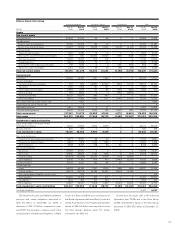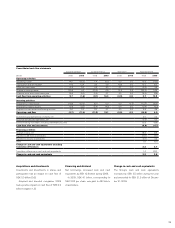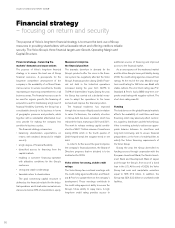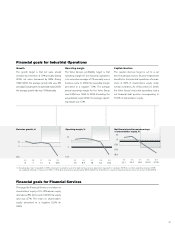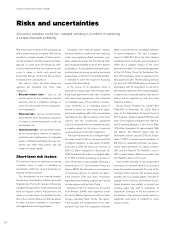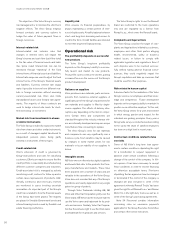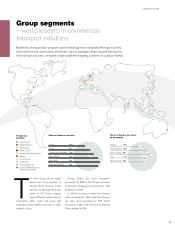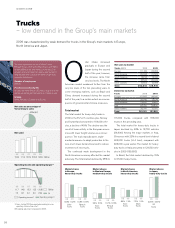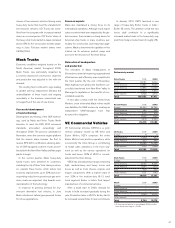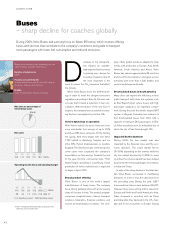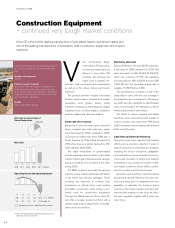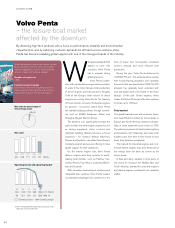Volvo 2009 Annual Report Download - page 40
Download and view the complete annual report
Please find page 40 of the 2009 Volvo annual report below. You can navigate through the pages in the report by either clicking on the pages listed below, or by using the keyword search tool below to find specific information within the annual report.
BOARD OF DIRECTORS’ REPORT 2009
The objective of the Volvo Group’s currency
risk management is to minimize the short-term
negative effects. The Volvo Group employs
forward contracts and currency options to
hedge the value of future payment flows in
foreign currencies.
Interest-related risk
Interest-related risk includes risks that
changes in interest rates will impact the
Group’s income and cash ow (cash ow risks)
or the fair value of nancial assets and liabil-
ities (price risks). Interest-rate risk can be
minimized through “matching” of the xed
interest terms of nancial assets and liabilities.
Interest rate swaps are used to adjust the xed
interest terms of the Group’s nancial assets
and liabilities. Currency interest rate swaps
make it possible to borrow from different mar-
kets in foreign currencies without assuming
currency-associated risk. Volvo also holds
standardized futures and forward rate agree-
ments. The majority of these contracts are
used to hedge interest rate levels for short-
term borrowing or investment.
Market risk from investments in shares
or similar instruments
The Volvo Group is indirectly exposed to market
risks from shares and other similar instruments,
as a result of managed capital transferred to
independent pension plans being partly
invested in instruments of these types.
Credit-related risk
Volvo’s extension of credit is governed by
Group-wide policies and rules for classifying
customers. Efforts are made to ensure that the
credit portfolio is reasonably diversied among
different customer categories and industries.
Credit-associated risk is managed by actively
monitoring credit, routines for follow up and in
certain cases repossession of products. Add-
itionally, continuous and necessary reserves
are monitored in cases involving uncertain
receivables. An important part of the Group’s
credit risk is related to how the nancial assets
of the Group have been placed. The majority
are placed in Swedish Government bonds and
interest-bearing bonds issued by Swedish real
estate nancing institutions.
Liquidity risk
Volvo ensures its nancial preparedness by
always maintaining a certain portion of reve-
nues in liquid assets. A healthy balance between
short- and long-term borrowing and access to
credit in the form of credit facilities are intended
to meet the long-term nancial needs.
Operational risk
The profitability depends on successful
new products
The Volvo Group’s long-term protability
depends on the Company’s ability to success-
fully launch and market its new products.
Product life cycles continue to shorten, putting
increased focus on the success of the Group’s
product development.
Reliance on suppliers
Volvo purchases raw materials, parts and com-
ponents from numerous external suppliers. A
signicant part of the Group’s requirements for
raw materials and supplies is lled by single-
source suppliers. The effects of delivery inter-
ruptions vary depending on the item or compo-
nent. Certain items and components are
standard throughout the industry, whereas oth-
ers are internally developed and require unique
tools that are time-consuming to replace.
The Volvo Group’s costs for raw materials
and components can vary signicantly over a
business cycle. Cost variations may be caused
by changes in world market prices for raw
ma terials or by an inability of our suppliers to
deliver.
Intangible assets
AB Volvo owns or otherwise has rights to patents
and brands that refer to the products the Com-
pany manufactures and markets. These have
been acquired over a number of years and are
valuable to the operations of the Volvo Group.
Volvo does not consider that any of the Group’s
operations are heavily dependent on any single
patent or group of patents.
Through Volvo Trademark Holding AB, AB
Volvo and Volvo Car Corporation jointly own the
Volvo brand. AB Volvo has the exclusive right to
use the Volvo name and trademark for its prod-
ucts and services. Similarly, Volvo Car Corpora-
tion has the exclusive right to use the Volvo name
and trademark for its products and services.
The Volvo Group’s rights to use the Renault
brand are restricted to the truck operations
only and are regulated by a license from
Renault s.a.s., which owns the Renault brand.
Complaints and legal actions
The Volvo Group could be the target of com-
plaints and legal actions initiated by customers,
employees and other third parties alleging
health, environmental, safety or business
related issues, or failure to comply with
ap plicable legislation and regulations. Even if
such disputes were to be resolved success-
fully, without having adverse nancial conse-
quences, they could negatively impact the
Group’s reputation and take up resources that
could be used for other purposes.
Risk related to human capital
A decisive factor for the realization of the Volvo
Group’s vision is our employees and their know-
ledge and competence. Future development
depends on the company’s ability to maintain its
position as an attractive employer. To this end,
the Volvo Group strives for a work environment
in which energy, passion and respect for the
individual are guiding principles. Every year a
Group-wide survey is conducted, and according
to the survey the share of satised employees
has been on a high level in recent years.
Contractual conditions related to take
over bids
Some of AB Volvo’s long term loan agree-
ments contain conditions stipulating the right
for a bondholder to request repayment in
advance under certain conditions following a
change of the control of the company. In Vol-
vo’s opinion it has been necessary to accept
those conditions in order to receive nancing
on otherwise acceptable terms. Provisions
stipulating that an agreement can be changed
or terminated if the control of the company is
changed are also included in some of the
agreements whereby Renault Trucks’ has been
given the right to sell Renault s.a.s.’ and Nissan
Motor Co. Ltd’s light-duty trucks as well as in
some of the Group’s purchasing agreements.
Note 34 Personnel contains information
concerning rules on severance payments
applicable for the Group Executive Committee
and certain other senior executives.
36



